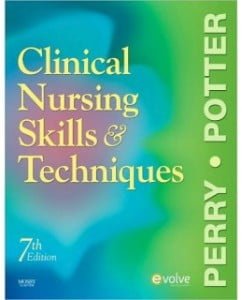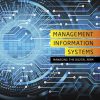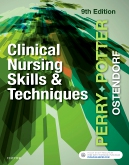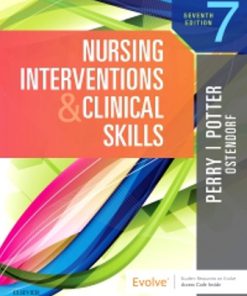Test Bank for Clinical Nursing Skills & Techniques, 7th Edition: Anne G. Perry
$35.00 Original price was: $35.00.$26.50Current price is: $26.50.
Test Bank for Clinical Nursing Skills & Techniques, 7th Edition: Anne G. Perry
This is completed downloadable of Test Bank for Clinical Nursing Skills & Techniques, 7th Edition: Anne G. Perry

Product Details:
- ISBN-10 : 0323052894
- ISBN-13 : 978-0323052894
- Author: Anne G. Perry
Learn clinical nursing skills and prepare for success on the Next Generation NCLEX® Examination! Clinical Nursing Skills & Techniques, 10th Edition provides clear, step-by-step guidelines to more than 200 basic, intermediate, and advanced skills. With more than 1,200 full-color illustrations, a nursing process framework, and a focus on evidence-based practice, this manual helps you learn to think critically, ask the right questions at the right time, and make timely decisions. New to this edition are NGN-style unfolding case studies, preparing you for the changes to the NCLEX exam. Written by respected nursing experts Anne Griffin Perry, Patricia A. Potter, Wendy Ostendorf, and Nancy Laplante, this trusted text is the bestselling nursing skills book on the market!
Table of Content:
-
Unit 1. Supporting the Patient Through the Health Care System
-
Introduction
-
1. Using evidence in nursing practice
-
Purpose
-
Practice standards
-
Supplemental standards
-
Principles for practice
-
Sustaining evidence-based practice changes
-
✦ Clinical review questions
-
References
-
2. Communication and collaboration
-
Purpose
-
Practice standards
-
Supplemental standards
-
Principles for practice
-
Patient-centered care
-
Evidence-based practice
-
Safety guidelines
-
✦ SKILL 2.1 Establishing the nurse-patient relationship
-
✦ SKILL 2.2 Communicating with patients who have difficulty coping
-
✦ SKILL 2.3 Communicating with a cognitively impaired patient
-
✦ SKILL 2.4 Communicating with colleagues
-
✦ SKILL 2.5 Workplace violence and safety
-
✦ Clinical review questions
-
References
-
3. Admitting, transfer, and discharge
-
Purpose
-
Practice standards
-
Supplemental standards
-
Principles for practice
-
Patient-centered care
-
Evidence-based practice
-
Safety guidelines
-
Admitting process
-
Transfer process
-
Discharge process
-
✦ Clinical review questions
-
References
-
4. Documentation and informatics
-
Purpose
-
Practice standards
-
Supplemental standards
-
Principles for practice
-
Patient-centered care
-
Evidence-based practice
-
Safety guidelines
-
Confidentiality
-
Legal guidelines in documentation
-
Guidelines for high-quality documentation
-
Methods of recording
-
Common electronic health record data screens
-
Documentation formats
-
Verbal reporting
-
Incident or adverse event occurrence reports
-
Home care documentation
-
Long-term health care documentation
-
✦ Clinical review questions
-
Phase 1
-
Phase 2
-
Phase 3
-
References
-
Unit 2. Vital Signs and Physical Assessment
-
Introduction
-
5. Vital signs
-
Purpose
-
Practice standards
-
Supplemental standards
-
Principles for practice
-
Patient-centered care
-
Evidence-based practice
-
Safety guidelines
-
✦ SKILL 5.1 Measuring body temperature
-
✦ SKILL 5.2 Assessing radial pulse
-
✦ SKILL 5.3 Assessing apical pulse
-
✦ SKILL 5.4 Assessing respirations
-
✦ SKILL 5.5 Assessing arterial blood pressure
-
✦ Clinical review questions
-
References
-
6. Health assessment
-
Purpose
-
Practice standards
-
Supplemental standards
-
Principles for practice
-
Patient-centered care
-
Evidence-based practice
-
Safety guidelines
-
Assessment techniques
-
Preparation for assessment
-
Physical assessment of various age-groups
-
✦ SKILL 6.1 General survey
-
✦ SKILL 6.2 Head and neck assessment
-
✦ SKILL 6.3 Thorax and lung assessment
-
✦ SKILL 6.4 Cardiovascular assessment
-
✦ SKILL 6.5 Abdominal assessment
-
✦ SKILL 6.6 Genitalia and rectum assessment
-
✦ SKILL 6.7 Musculoskeletal and neurological assessment
-
✦ Clinical review questions
-
Phase 1
-
Phase 2
-
Phase 3
-
References
-
Unit 3. Special Procedures
-
Introduction
-
7. Specimen collection
-
Purpose
-
Practice standards
-
Supplemental standards
-
Principles for practice
-
Patient-centered care
-
Evidence-based practice
-
Safety guidelines
-
✦ SKILL 7.1 Urine specimen collection: Midstream (clean-voided) urine; sterile urinary catheter
-
✦ SKILL 7.2 Measuring occult blood in stool
-
✦ SKILL 7.3 Measuring occult blood in gastric secretions (gastroccult)
-
✦ SKILL 7.4 Collecting nose and throat specimens for culture
-
✦ SKILL 7.5 Obtaining vaginal or urethral discharge specimens
-
✦ SKILL 7.6 Collecting a sputum specimen by suction
-
✦ SKILL 7.7 Obtaining wound drainage specimens
-
✦ SKILL 7.8 Collecting blood specimens and culture by venipuncture (syringe and vacutainer method)
-
✦ SKILL 7.9 Blood glucose monitoring
-
✦ SKILL 7.10 Obtaining an arterial specimen for blood gas measurement
-
✦ Clinical review questions
-
References
-
8. Diagnostic procedures
-
Purpose
-
Practice standards
-
Supplemental standards
-
Principles for practice
-
Patient-centered care
-
Evidence-based practice
-
Safety guidelines
-
✦ SKILL 8.1 Intravenous moderate sedation
-
✦ SKILL 8.2 Contrast media studies: Arteriogram (angiogram), cardiac catheterization, and intravenous pyelogram (IVP)
-
✦ SKILL 8.3 Care of patients undergoing aspirations: Bone marrow aspiration/biopsy, lumbar puncture, paracentesis, and thoracentesis
-
✦ SKILL 8.4 Care of a patient undergoing bronchoscopy
-
✦ SKILL 8.5 Care of a patient undergoing endoscopy
-
✦ Clinical review questions
-
Phase 1
-
Phase 2
-
Phase 3
-
References
-
Unit 4. Infection Control
-
Introduction
-
9. Medical asepsis
-
Purpose
-
Practice standards
-
Supplemental standards
-
Principles for practice
-
Patient-centered care
-
Evidence-based practice
-
Safety guidelines
-
✦ SKILL 9.1 Hand hygiene
-
✦ SKILL 9.2 Caring for patients under isolation precautions
-
✦ Clinical review questions
-
References
-
10. Sterile technique
-
Purpose
-
Practice standards
-
Supplemental standards
-
Principles for practice
-
Patient-centered care
-
Evidence-based practice
-
Safety guidelines
-
✦ SKILL 10.1 Applying and removing cap, mask, and protective eyewear
-
✦ SKILL 10.2 Preparing a sterile field
-
✦ SKILL 10.3 Sterile gloving
-
✦ Clinical review questions
-
Phase 1
-
Phase 2
-
Phase 3
-
References
-
Unit 5. Activity and Mobility
-
Introduction
-
11. Safe patient handling and mobility
-
Purpose
-
Practice standards
-
Principles for practice
-
Patient-centered care
-
Evidence-based practice
-
Safety guidelines
-
✦ SKILL 11.1 Using safe and effective transfer techniques
-
✦ SKILL 11.2 Moving and positioning patients in bed
-
✦ Clinical review questions
-
References
-
12. Exercise, mobility, and immobilization devices
-
Purpose
-
Practice standards
-
Principles for practice
-
Patient-centered care
-
Evidence-based practice
-
Safety guidelines
-
✦ SKILL 12.1 Promoting early activity and exercise
-
✦ SKILL 12.2 Assisting with use of canes, walkers, and crutches
-
✦ SKILL 12.3 Care of a patient with an immobilization device
-
✦ Clinical review questions
-
References
-
13. Support surfaces and special beds
-
Purpose
-
Practice standards
-
Supplemental standards
-
Principles for practice
-
Patient-centered care
-
Evidence-based practice
-
Safety guidelines
-
✦ SKILL 13.1 Care of the patient on a support surface
-
✦ SKILL 13.2 Care of the patient on a special bed
-
✦ Clinical review questions
-
Phase 1
-
Phase 2
-
Phase 3
-
References
-
Unit 6. Safety and Comfort
-
Introduction
-
14. Patient safety
-
Purpose
-
Practice standards
-
Supplemental standards
-
Principles for practice
-
Patient-centered care
-
Evidence-based practice
-
Safety guidelines
-
✦ SKILL 14.1 Fall prevention in health care settings
-
✦ SKILL 14.2 Designing a restraint-free environment
-
✦ SKILL 14.3 Applying physical restraints
-
✦ SKILL 14.4 Seizure precautions
-
✦ Clinical review questions
-
References
-
15. Disaster preparedness
-
Purpose
-
Practice standards
-
Supplemental standards
-
Principles for practice
-
Patient-centered care
-
Evidence-based practice
-
Safety guidelines
-
✦ SKILL 15.1 Care of a patient after biological exposure
-
✦ SKILL 15.2 Care of a patient after chemical exposure
-
✦ SKILL 15.3 Care of a patient after radiation exposure
-
✦ SKILL 15.4 Care of a patient after a natural disaster
-
✦ Clinical review questions
-
References
-
16. Pain management
-
Purpose
-
Practice standards
-
Supplemental standards
-
Principles for practice
-
Patient-centered care
-
Evidence-based practice
-
Safety guidelines
-
✦ SKILL 16.1 Pain assessment and basic comfort measures
-
✦ SKILL 16.2 Nonpharmacological pain management
-
✦ SKILL 16.3 Pharmacological pain management
-
✦ SKILL 16.4 Patient-controlled analgesia
-
✦ SKILL 16.5 Epidural analgesia
-
✦ SKILL 16.6 Local anesthetic infusion pump for analgesia
-
✦ SKILL 16.7 Moist and dry heat applications
-
✦ SKILL 16.8 Cold application
-
✦ Clinical review questions
-
References
-
17. End-of-life care
-
Purpose
-
Practice standards
-
Principles for practice
-
Patient-centered care
-
Evidence-based practice
-
Safety guidelines
-
✦ SKILL 17.1 Supporting patients and families in grief
-
✦ SKILL 17.2 Symptom management at the end of life
-
✦ SKILL 17.3 Care of the body after death
-
✦ Clinical review questions
-
Phase 1
-
Phase 2
-
Phase 3
-
References
-
Unit 7. Hygiene
-
Introduction
-
18. Personal hygiene and bed making
-
Purpose
-
Practice standards
-
Supplemental standards
-
Principles for practice
-
Patient-centered care
-
Evidence-based practice
-
Safety guidelines
-
The skin
-
The mouth
-
The hair
-
The nails
-
✦ SKILL 18.1 Complete or partial bed bath
-
✦ SKILL 18.2 Oral hygiene
-
✦ SKILL 18.3 Performing mouth care for an unconscious or debilitated patient
-
✦ SKILL 18.4 Performing nail and foot care
-
✦ Clinical review questions
-
References
-
19. Care of the eye and ear
-
Purpose
-
Practice standards
-
Principles for practice
-
Patient-centered care
-
Evidence-based practice
-
Safety guidelines
-
✦ SKILL 19.1 Eye irrigation
-
✦ SKILL 19.2 Ear irrigation
-
✦ SKILL 19.3 Care of hearing aids
-
✦ Clinical review questions
-
Phase 1
-
Phase 2
-
Phase 3
-
References
-
Unit 8. Medications
-
Introduction
-
20. Safe medication preparation
-
Practice standards
-
Supplemental standards
-
Principles for practice
-
Patient-centered care
-
Evidence-based practice
-
Safety guidelines
-
Nursing process
-
Reporting medication errors
-
Patient and family caregiver teaching
-
✦ Clinical review questions
-
References
-
21. Nonparenteral medications
-
Purpose
-
Practice standards
-
Supplemental standards
-
Principles for practice
-
Patient-centered care
-
Evidence-based practice
-
Safety guidelines
-
✦ SKILL 21.1 Administering oral medications
-
✦ SKILL 21.2 Administering medications through a feeding tube
-
✦ SKILL 21.3 Applying topical medications to the skin
-
✦ SKILL 21.4 Administering ophthalmic medications
-
✦ SKILL 21.5 Administering ear medications
-
✦ SKILL 21.6 Administering nasal instillations
-
✦ SKILL 21.7 Using metered-dose inhalers (MDIs)
-
✦ SKILL 21.8 Using small-volume nebulizers
-
✦ Clinical review questions
-
References
-
22. Parenteral medications
-
Purpose
-
Practice standards
-
Supplemental standards
-
Principles for practice
-
Patient-centered care
-
Evidence-based practice
-
Safety guidelines
-
✦ SKILL 22.1 Preparing injections: Ampules and vials
-
✦ SKILL 22.2 Administering intradermal injections
-
✦ SKILL 22.3 Administering subcutaneous injections
-
✦ SKILL 22.4 Administering intramuscular injections
-
✦ SKILL 22.5 Administering medications by intravenous bolus
-
✦ SKILL 22.6 Administering intravenous medications by piggyback and syringe pumps
-
✦ SKILL 22.7 Administering medications by continuous subcutaneous infusion
-
✦ Clinical review questions
-
Phase 1
-
Phase 2
-
Phase 3
-
References
-
Unit 9. Oxygenation
-
Introduction
-
23. Oxygen therapy
-
Purpose
-
Practice standards
-
Supplemental standards
-
Principles for practice
-
Patient-centered care
-
Evidence-based practice
-
Safety guidelines
-
✦ SKILL 23.1 Applying an oxygen-delivery device
-
✦ SKILL 23.2 Administering oxygen therapy to a patient with an artificial airway
-
✦ SKILL 23.3 Using incentive spirometry
-
✦ SKILL 23.4 Care of a patient receiving noninvasive positive pressure ventilation
-
✦ SKILL 23.5 Care of a patient on a mechanical ventilator
-
✦ Clinical review questions
-
References
-
24. Performing chest physiotherapy
-
Purpose
-
Practice standards
-
Supplemental standards
-
Principles for practice
-
Patient-centered care
-
Evidence-based practice
-
Safety guidelines
-
✦ SKILL 24.1 Performing postural drainage
-
✦ Clinical review questions
-
References
-
25. Airway management
-
Purpose
-
Practice standards
-
Supplemental standards
-
Principles for practice
-
Patient-centered care
-
Evidence-based practice
-
Safety guidelines
-
✦ SKILL 25.1 Performing oropharyngeal suctioning
-
✦ SKILL 25.2 Airway suctioning
-
✦ SKILL 25.3 Performing endotracheal tube care
-
✦ SKILL 25.4 Performing tracheostomy care
-
✦ Clinical review questions
-
References
-
26. Cardiac care
-
Purpose
-
Practice standards
-
Supplemental standards
-
Principles for practice
-
Patient-centered care
-
Evidence-based practice
-
Safety guidelines
-
✦ SKILL 26.1 Obtaining a 12-lead electrocardiogram
-
✦ SKILL 26.2 Applying a cardiac monitor
-
✦ Clinical review questions
-
References
-
27. Closed chest drainage systems
-
Purpose
-
Practice standards
-
Supplemental standards
-
Principles for practice
-
Patient-centered care
-
Evidence-based practice
-
Safety guidelines
-
✦ SKILL 27.1 Managing closed chest drainage systems
-
✦ SKILL 27.2 Assisting with removal of chest tubes
-
✦ SKILL 27.3 Autotransfusion of chest tube drainage
-
✦ Clinical review questions
-
References
-
28. Emergency measures for life support
-
Purpose
-
Practice standards
-
Supplemental standards
-
Principles for practice
-
Patient-centered care
-
Evidence-based practice
-
Safety guidelines
-
✦ SKILL 28.1 Inserting an oropharyngeal airway
-
✦ SKILL 28.2 Using an automated external defibrillator
-
✦ SKILL 28.3 Resuscitation management
-
✦ Clinical review questions
-
Phase 1
-
Phase 2
-
Phase 3
-
References
-
Unit 10. Fluid Balance
-
Introduction
-
29. Intravenous and vascular access therapy
-
Purpose
-
Practice standards
-
Supplemental standards
-
Principles for practice
-
Patient-centered care
-
Evidence-based practice
-
Safety guidelines
-
✦ SKILL 29.1 Insertion of a short-peripheral intravenous device
-
✦ SKILL 29.2 Regulating intravenous flow rates
-
✦ SKILL 29.3 Changing intravenous solutions
-
✦ SKILL 29.4 Changing infusion tubing
-
✦ SKILL 29.5 Changing a short-peripheral intravenous dressing
-
✦ SKILL 29.6 Managing central vascular access devices
-
✦ Clinical review questions
-
References
-
30. Blood therapy
-
Purpose
-
Standards of care
-
Supplemental standards
-
Principles for practice
-
Patient-centered care
-
Evidence-based practice
-
Safety guidelines
-
✦ SKILL 30.1 Initiating blood therapy
-
✦ SKILL 30.2 Monitoring for adverse transfusion reactions
-
✦ Clinical review questions
-
Phase 1
-
Phase 2
-
Phase 3
-
References
-
Unit 11. Nutrition
-
Introduction
-
31. Oral nutrition
-
Purpose
-
Practice standards
-
Supplemental standards
-
Principles for practice
-
Patient-centered care
-
Evidence-based practice
-
Safety guidelines
-
✦ SKILL 31.1 Performing a nutritional screening and physical examination
-
✦ SKILL 31.2 Assisting an adult patient with oral nutrition
-
✦ SKILL 31.3 Aspiration precautions
-
✦ Clinical review questions
-
References
-
32. Enteral nutrition
-
Purpose
-
Practice standards
-
Supplemental standards
-
Principles for practice
-
Patient-centered care
-
Evidence-based practice
-
Safety guidelines
-
✦ SKILL 32.1 Insertion and removal of a small-bore feeding tube
-
✦ SKILL 32.2 Verifying placement of a feeding tube
-
✦ SKILL 32.3 Irrigating a feeding tube
-
✦ SKILL 32.4 Administering enteral nutrition: Nasogastric, nasointestinal, gastrostomy, or jejunostomy tube
-
✦ Clinical review questions
-
References
-
33. Parenteral nutrition
-
Purpose
-
Practice standards
-
Supplemental standards
-
Principles for practice
-
Patient-centered care
-
Evidence-based practice
-
Safety guidelines
-
✦ SKILL 33.1 Administering central parenteral nutrition
-
✦ SKILL 33.2 Administering peripheral parenteral nutrition with lipid (fat) emulsion
-
✦ Clinical review questions
-
Phase 1
-
Phase 2
-
Phase 3
-
References
-
Unit 12. Elimination
-
Introduction
-
34. Urinary elimination
-
Purpose
-
Practice standards
-
Supplemental standards
-
Principles for practice
-
Patient-centered care
-
Evidence-based practice
-
Safety guidelines
-
✦ SKILL 34.1 Insertion of a straight or an indwelling urinary catheter
-
✦ SKILL 34.2 Care and removal of an indwelling catheter
-
✦ SKILL 34.3 Performing catheter irrigation
-
✦ SKILL 34.4 Applying a male incontinence device
-
✦ SKILL 34.5 Suprapubic catheter care
-
✦ Clinical review questions
-
References
-
35. Bowel eliminationand gastric intubation
-
Purpose
-
Practice standards
-
Principles of practice
-
Patient-centered care
-
Evidence-based practice
-
Safety guidelines
-
✦ SKILL 35.1 Administering an enema
-
✦ SKILL 35.2 Insertion, maintenance, and removal of a nasogastric tube for gastric decompression
-
✦ Clinical review questions
-
References
-
36. Ostomy care
-
Purpose
-
Practice standards
-
Supplemental standards
-
Principles for practice
-
Patient-centered care
-
Evidence-based practice
-
Safety guidelines
-
✦ SKILL 36.1 Pouching a colostomy or an ileostomy
-
✦ SKILL 36.2 Pouching a urostomy
-
✦ SKILL 36.3 Catheterizing a urinary diversion
-
✦ Clinical review questions
-
Phase 1
-
Phase 2
-
Phase 3
-
References
-
Unit 13. Care of the Surgical Patient
-
Introduction
-
37. Preoperative and postoperative care
-
Purpose
-
Practice standards
-
Supplemental standards
-
Principles for practice
-
Patient-centered care
-
Evidence-based practice
-
Safety guidelines
-
✦ SKILL 37.1 Preoperative assessment
-
✦ SKILL 37.2 Preoperative teaching
-
✦ SKILL 37.3 Patient preparation for surgery
-
✦ SKILL 37.4 Providing immediate anesthesia recovery in the postanesthesia care unit
-
✦ SKILL 37.5 Providing early postoperative (phase II) and convalescent phase (phase III) recovery
-
✦ Clinical review questions
-
References
-
38. Intraoperative care
-
Purpose
-
Practice standards
-
Supplemental standards
-
Principles for practice
-
Patient-centered care
-
Evidence-based practice
-
Safety guidelines
-
✦ SKILL 38.1 Surgical hand antisepsis
-
✦ SKILL 38.2 Donning a sterile gown and closed gloving
-
✦ Clinical review questions
-
Phase 1
-
Phase 2
-
Phase 3
-
References
-
Unit 14. Dressings and Wound Care
-
Introduction
-
39. Wound care and irrigation
-
Purpose
-
Practice standards
-
Supplemental standards
-
Principles for practice
-
Patient-centered care
-
Evidence-based practice
-
Safety guidelines
-
✦ SKILL 39.1 Performing a wound irrigation
-
✦ SKILL 39.2 Removing sutures and staples
-
✦ SKILL 39.3 Managing wound drainage evacuation
-
✦ SKILL 39.4 Negative-pressure wound therapy
-
✦ Clinical review questions
-
References
-
40. Pressure injury prevention and care
-
Purpose
-
Practice standards
-
Supplemental standards
-
Principles for practice
-
Patient-centered care
-
Evidence-based practice
-
Safety guidelines
-
✦ SKILL 40.1 Risk assessment, skin assessment, and prevention strategies
-
✦ SKILL 40.2 Treatment of pressure injuries
-
✦ Clinical review questions
-
References
-
41. Dressings, bandages, and binders
-
Purpose
-
Practice standards
-
Supplemental standards
-
Principles for practice
-
Patient-centered care
-
Evidence-based practice
-
Safety guidelines
-
✦ SKILL 41.1 Applying a dressing (dry and moist dressings)
-
✦ SKILL 41.2 Applying a pressure bandage
-
✦ SKILL 41.3 Applying a transparent dressing
-
✦ SKILL 41.4 Applying a hydrocolloid, hydrogel, foam, or alginate dressing
-
✦ Clinical review questions
-
Phase 1
-
Phase 2
-
Phase 3
-
References
-
Unit 15. Home Care
-
Introduction
-
42. Home care safety
-
Purpose
-
Practice standards
-
Principles for practice
-
Client-centered care
-
Evidence-based practice
-
Safety guidelines
-
✦ SKILL 42.1 Home environment assessment and safety
-
✦ SKILL 42.2 Adapting the home setting for clients with cognitive deficits
-
✦ SKILL 42.3 Medication and medical device safety
-
✦ Clinical review questions
-
References
-
43. Home care teaching
-
Purpose
-
Practice standards
-
Supplemental standards
-
Principles for practice
-
Client-centered care
-
Evidence-based practice
-
Safety guidelines
-
✦ SKILL 43.1 Teaching clients to measure body temperature
-
✦ SKILL 43.2 Teaching blood pressure and pulse measurement
-
✦ SKILL 43.3 Teaching intermittent self-catheterization
-
✦ SKILL 43.4 Using home oxygen equipment
-
✦ SKILL 43.5 Teaching home tracheostomy care and suctioning
-
✦ SKILL 43.6 Teaching medication self-administration
-
✦ SKILL 43.7 Managing feeding tubes in the home
-
✦ SKILL 43.8 Managing parenteral nutrition in the home
-
✦ Clinical review questions
-
Phase 1
-
Phase 2
-
Phase 3
-
References
-
Appendix A: Terminology/combining forms Prefixes and suffixes
-
Answers to clinical review questions
-
Answers to Next-Generation NCLEX® (NGN)–Style Unfolding Case Studies
-
Index
-
Index of skills and procedural guidelines
People Also Search:
clinical nursing skills & techniques
clinical nursing skills & techniques 7th edition
clinical nursing skills & techniques 7th edition test bank download pdf
clinical nursing skills & techniques 7th edition download scribd












